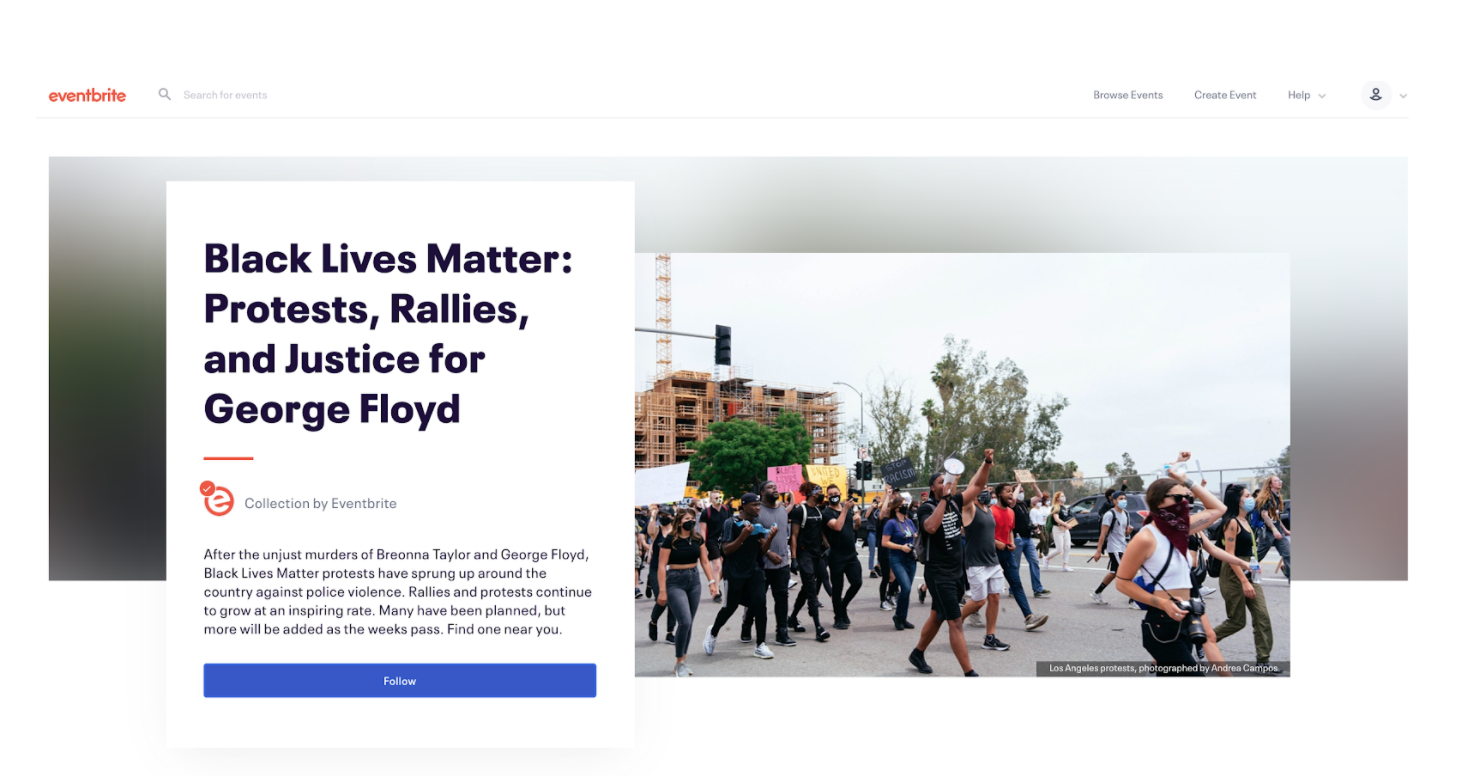Sometimes, a project that you’re most proud of or passionate about isn’t one that involves architecture diagrams or deep technical discussions. Sometimes, the most significant project is one that allows peers to come together to build something that can have a positive impact. When we can all collaborate for a cause we’re passionate about, and get quick buy-in from our colleagues and executives, we can create a feature we’re proud of.
Such is the case with Eventbrite’s Protests map. If you’ve visited the Eventbrite homepage recently, you’ve probably seen our map highlighting protests and marches to support racial equality, hosted on Eventbrite.

The map features events across the U.S., and the data source for the events shown is a Curated Collection.

The birth of a map
On May 25, 2020, news of George Floyd’s murder in Minneapolis spread rapidly across the country, igniting protests and rallies seeking justice. On June 9, a small team consisting of a product manager, engineer, designer, and content editor came together to build a map for these events on Eventbrite.com.
The plan was to create a map on Eventbrite that led users to protests across the United States. This map would aggregate Black Lives Matter protests and allow our users to interact based on their location. While some projects exemplify technical ingenuity of a team, this one relied on quick thinking and action, teamwork, and a driving force of passion. There are always a number of technical solutions to test out, but sometimes it’s simpler to leverage people.
Company buy-in and teamwork
The fact that this map lives on our homepage means that everyone, including event organizers and consumers would see this high-touch feature. That means that we needed quick buy-in from the whole company, especially impacted department leads, to launch this feature while protests were still occurring nation-wide. This project was greenlit in a matter of days.
The trust involved in getting this map out the door was important to our success. Legal, PR, and marketing all came together to bring this project to life, it was a true cross-functional effort.
Collections and discovery
When we were in the brainstorming phase, we faced the question of how to populate the map with events that were specifically protests in support of Black Lives Matter. Our first instinct was to construct a query to identify events that would fit into the theme.
For a simple example, we could return events where the event’s organizer had selected the “Rally” format when they created the event. Then further filter those results by events where the organizer had entered a description containing the text “BLM” or “George Floyd.”
We quickly realized this wasn’t going to produce good results. Variations on this approach would either be over-specific or too broad, including far too many irrelevant events or excluding relevant ones. Plus, it would have been vulnerable to trolling and require us to constantly adjust the query as people learned how to configure their events to show up on the map.
It was probably naive to have even tried that approach, but the obvious alternative had its downsides too. The alternative being manual, human-driven curation through the use of an existing feature on our platform called “Collections.”
Collections allow Eventbrite users to create collections of events. Any user on Eventbrite can create a collection simply by clicking the “heart” icon on an event card:

Our marketing team uses this feature to highlight particularly interesting events that adhere to certain themes: online yoga classes, drive-in concerts, etc. Sometimes you’ll see it in our product under the name of “Editor’s Picks.”
But as mentioned above, this approach has downsides. It takes significant manual work to identify all the events that we want to be part of the collection. And event inventory has a unique challenge: events end. At some point in time, a planned event will take place and the content is no longer relevant to show consumers. The Collections feature depends on the same Elasticsearch index we use for search, and due to various constraints we actively remove events from the index after they end.
Since we remove ended events, we run the risk of showing a sparse or empty map if we don’t maintain the collection. This meant that someone would have to constantly keep an eye on this collection and keep it updated with new events as people create them on our platform.
Luckily, we had help.
The initial list of protests came together through help from the rest of the company, specifically our company’s global diversity group, collaborating on Slack and Google Sheets.
After we launched, Eventbrite Co-founder and CEO, Julia Hartz was so inspired by the work that she offered extra funding for the marketing team to continue the work of identifying relevant events for the map. That’s some of the most positive internal feedback you can get!
The nuts-and-bolts
While this was a straightforward project from a technical implementation standpoint, for the most part leveraging an existing feature rather than building something entirely new, it’s worth highlighting the work we’ve done in Eventbrite Engineering over the past year to invest in our architecture and infrastructure. Like many companies, Eventbrite is undergoing the difficult process of moving away from a monolithic architecture to a microservices architecture (ours has a domain-driven spin). We call the monolith “Core.”
Although we’re nowhere close to finished, we’re already starting to reap the benefits of the hard work invested in moving features out of Core, piece by piece. A little over a year ago, it wouldn’t have been feasible to ship a project of this nature so quickly because deploying any part of the site, no matter how small, required deploying all of Core. Today, we can ship changes to the homepage within a matter of minutes.
Just as importantly, we have reliable alerting to notify us of problems that arise after shipping a change. As a matter of fact, shortly after we launched this project we were alerted of an unusual spike in errors on the homepage. Within 5 minutes of receiving this notification, we rolled back the release containing the map. After another 10 minutes, we re-released the map with the fix.
Bringing people together
Our company’s mission is simple: Bring the world together through live experiences. Protests themselves bring together like-minded individuals to fight towards a common goal. Working on a feature that exemplifies our mission as a company was a truly inspiring opportunity. This lit a fire in our team that translated to the company as a whole.
Authors: Eloise Porter, Jaylum Chen, Alex Rice, and Allen Jilo


Fantastic work and love the article